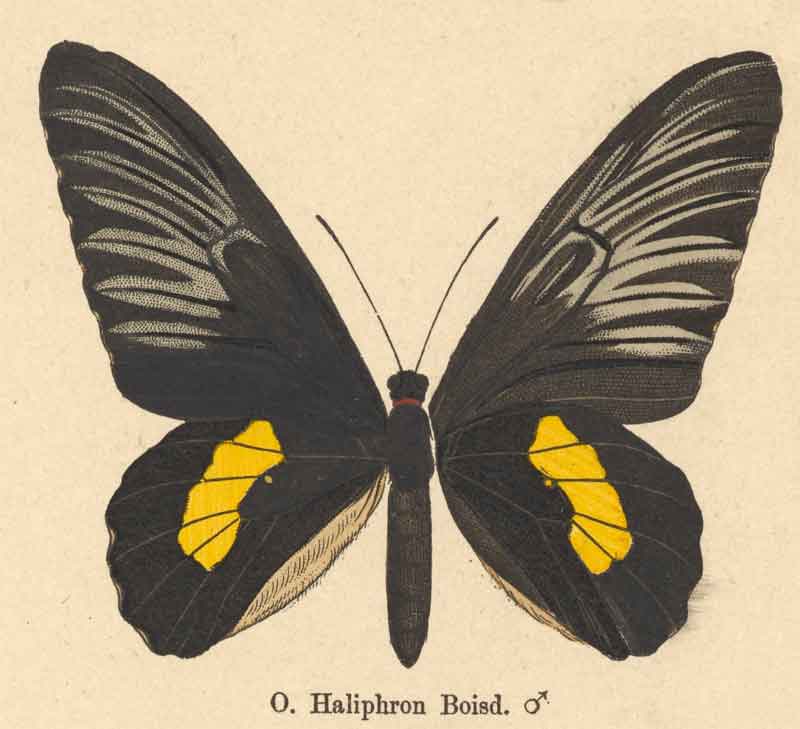
Superregnum: Eukaryota
Regnum: Animalia
Subregnum: Eumetazoa
Cladus: Bilateria
Cladus: Nephrozoa
Cladus: Protostomia
Cladus: Ecdysozoa
Cladus: Panarthropoda
Phylum: Arthropoda
Subphylum: Hexapoda
Classis: Insecta
Cladus: Dicondylia
Subclassis: Pterygota
Cladus: Metapterygota
Infraclassis: Neoptera
Cladus: Eumetabola
Cladus: Endopterygota
Superordo: Panorpida
Cladus: Amphiesmenoptera
Ordo: Lepidoptera
Subordo: Glossata
Cladus: Coelolepida
Cladus: Myoglossata
Cladus: Neolepidoptera
Infraordo: Heteroneura
Cladus: Eulepidoptera
Cladus: Ditrysia
Cladus: Apoditrysia
Cladus: Obtectomera
Superfamilia: Papilionoidea
Familia: Papilionidae
Subfamilia: Papilioninae
Tribus: Troidini
Subtribus: Troidina
Genus: Troides
Subgenus: Troides
Species: Troides haliphron
Subspecies: T. h. haliphron – T. h. rikyu
Name
Troides haliphron (Boisduval, 1836)
Image: 1860.
Synonymy
Ornithoptera haliphron Boisduval, 1836 (original combination)
Troides haliphron (Boisduval, 1836),
References
Primary references
Additional references
Attal, S. & Jeannot, G. 2020. Une forme spectaculaire chez Troides halþhronhaliphron (Boisduval, 1836) (Lepidoptera Papilionidae Papilioninae Troidini). Antenor 7(1): 11-13. Reference page. '
Troides haliphron, the haliphron birdwing, is a birdwing butterfly confined to Sulawesi and the lesser Sunda Islands.
Contents
Description
For explanation of terms, see External morphology of Lepidoptera.
Troides haliphron is sexually dimorphic.
Male: The forewings are ground colour black. The veins are bordered by white shading. The hindwings are ground colour black. There is a golden band in the discal area of the wing. The veins are black and they cleave the golden area. The underside is similar.
Female: The female is larger than the male. The ground colour of the female is brown. The veins are bordered by white shading. There is a yellow area with dark veins on the hindwings. There is one chain of black spots is in the yellow area. The underside is similar.
The abdomen is dark brown, and the underside has yellow spots. Head and thorax are black. The nape has a red hair coat.
Taxonomy
Troides staudingeri has at times been considered a subspecies of Troides haliphron.
Subspecies celebensis - the status of this taxon is uncertain. It has been placed within Troides criton, and Troides oblongomaculatus. It may be a hybrid with Troides helena hephaestus.
Subspecies
A number of other subspecies have been described from different islands. They are:
T. h. celebensis - possibly central Celebes (see Taxonomy)
T. h. haliphron - South Celebes
T. h. naias - Sumba
T. h. socrates - Wetar and Sumbawa (probably a local form and not a subspecies)
T. h. selayarensis - Selayar Islands
Biology
The larva feeds on species Aristolochia.
Related species
Troides haliphron is a member of the Troides haliphron species group. The members of this clade are:
Troides haliphron (Boisduval, 1836)
Troides darsius (Gray, [1853])
Troides vandepolli (Snellen, 1890)
Troides criton (C. & R. Felder, 1860)
Troides riedeli (Kirsch, 1885)
Troides plato (Wallace, 1865)
Troides staudingeri (Röber, 1888)
References
Collins, N. Mark; Morris, Michael G. (1985). Threatened Swallowtail Butterflies of the World: The IUCN Red Data Book. Gland & Cambridge: IUCN. ISBN 978-2-88032-603-6 – via Biodiversity Heritage Library.
D'Abrera, B. (1975) Birdwing Butterflies of the World. Country Life Books, London.
Haugum, J. & Low, A.M. 1978-1985. A Monograph of the Birdwing Butterflies. 2 volumes. Scandinavian Press, Klampenborg; 663 pp.
Kurt Rumbucher and Oliver Schäffler, 2004 Part 19, Papilionidae X. Troides III. in Erich Bauer and Thomas Frankenbach Eds. Butterflies of the World. Keltern: Goecke & Evers ISBN 978-3-937783-02-4
Retrieved from "http://en.wikipedia.org/"
All text is available under the terms of the GNU Free Documentation License

